Bulletin – March 2011 The Emergence of the Chinese Automobile Sector
- Download the article 212KB
Abstract
The Chinese automobile sector has experienced rapid growth over the past decade, with China recently becoming the world's largest producer of automobiles. Given the steel-intensive nature of automobile production, the expansion of China's automobile sector has seen it become an important end-user of steel. With the number of cars in China still very low relative to its large population, car sales are likely to remain at a high level for the foreseeable future; accordingly, Chinese car makers should remain a significant (and growing) source of demand for steel.
Introduction
The Chinese automobile sector has expanded rapidly over the past decade. Growth has been particularly strong over 2009 and 2010 (boosted by various stimulus measures), with production and sales of automobiles doubling over this period (Graph 1). As a result of this strong growth, China became the world's largest producer of automobiles in 2009 (as measured by the number of vehicles produced; Graph 2).
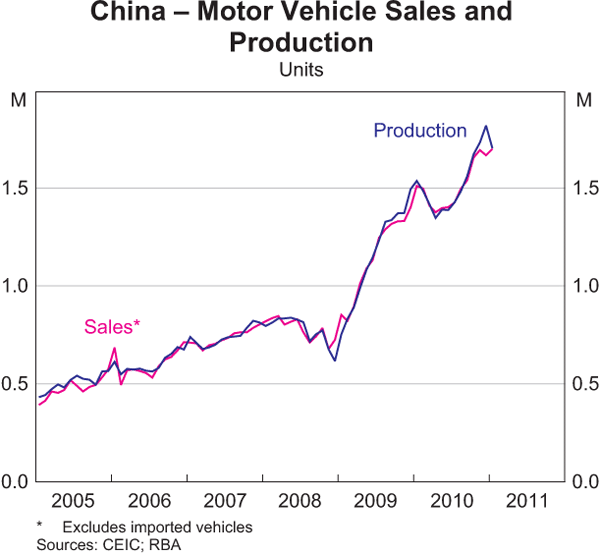
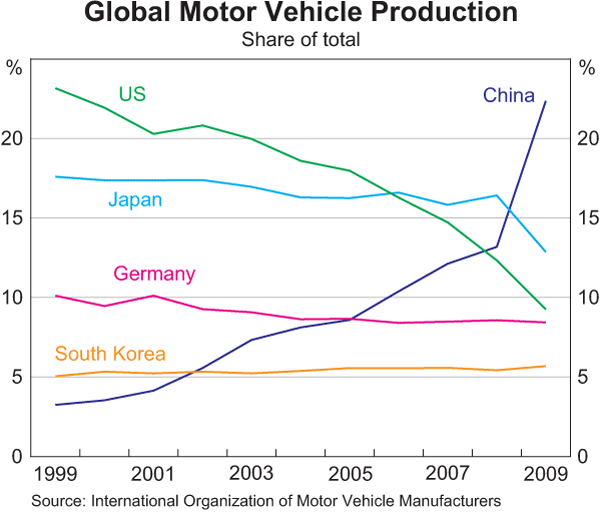
The recent surge in automobile production has seen the sector become an important end-user of steel, accounting for 8 per cent of China's total steel consumption in 2009 (MofCOM 2010). According to the China Iron and Steel Association, between 50 and 60 per cent of the weight of a typical car is made up of steel and a further 12 to 15 per cent comprises cast iron (CISA 2008). Developments in automobile production consequently play an important role in determining Chinese demand for steel and therefore iron ore. Reflecting the growing importance of the industry, this article discusses the historical development of the Chinese automobile sector, before turning to more recent developments and future prospects.
History and Overview
Since general market-based reforms were introduced in China around 30 years ago, restrictions and controls on the automobile sector have been gradually eased. Prior to these reforms, Chinese state-owned automobile manufacturers primarily focused on large commercial trucks, with only a small number of passenger cars being produced. In the 1980s and early 1990s, the Government began to approve joint venture partnerships with major global automobile manufacturers in order to develop China's domestic production capabilities. Technology and knowledge transfers through these partnerships were an integral part of the early development of the modern industry.
An important step in the development of the industry was the 1994 Automobile Industry Policy. One of the policy's aims was to attract large internationally established manufacturers to operate in China under joint venture, with foreign ownership of such ventures restricted to no more than 50 per cent. The new policy also urged consolidation in the auto sector, indicative of the broader restructuring of Chinese state-owned enterprises throughout the 1990s (Naughton 2007). Beijing-based First Automobile Works (FAW), Shanghai Automotive Industry Corporation (SAIC) and Hubei-based Dongfeng Motors (the so-called ‘big three’) all participated in the early joint ventures prior to the introduction of the policy in 1994 and continued to be major participants in joint ventures subsequently. The Government's focus on consolidation of the sector and the development of the large established state-owned enterprises meant that smaller producers not involved in joint ventures faced restrictions on market entry and product development throughout the 1990s.
Automobile production began to pick up significantly at the start of the 2000s, consistent with stronger overall growth in the Chinese economy (Graph 3). Higher production was associated with increased domestic competition with a number of new state-owned and private manufacturers entering the market. The passenger car market, in particular, grew rapidly throughout the decade, while commercial vehicle production expanded at a more subdued pace. In 2004, the Government updated the Automobile Industry Policy which placed greater emphasis on domestic research and development and also removed the 50 per cent restriction on foreign ownership for joint ventures located in any of China's export processing zones.
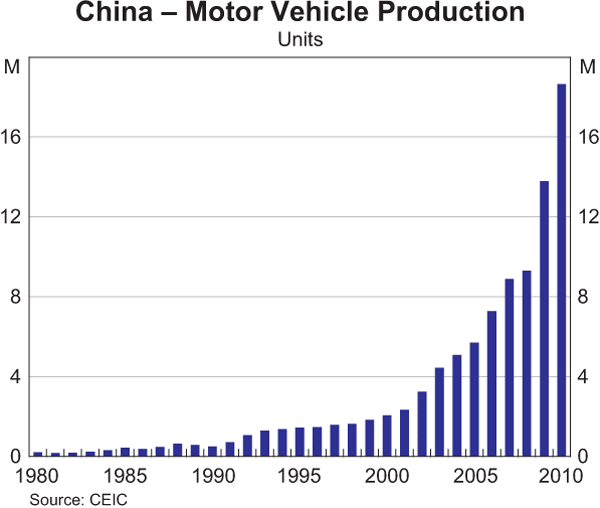
On average, Chinese-produced cars are cheaper than those produced in advanced economies. Price data from the National Development and Reform Commission (NDRC) show that the average price of automobiles sold in 2010 was just under CNY68,000 (around A$11,000). In addition to relatively low labour costs, domestic producers have been able to keep prices low by using established technologies and models obtained through various joint venture partnerships. The more established joint venture producers (particularly the ‘big three’) continue to be the largest manufacturers, with sales of passenger cars in China dominated by models of foreign brands such as GM and Volkswagen produced by these joint ventures (Table 1). However, some of the independent producers that entered the passenger vehicle market in the late 1990s and early 2000s, who produce vehicles under their own brand, have since gained market share; for example, Anhui-based Chery and Guangdong-based BYD, both featured among the 10 highest selling manufacturers in 2010 (Table 1).
| Manufacturer | Sales Units | Market share(a) Per cent |
|---|---|---|
| SAIC-GM-Wuling | 1,135,600 | 8.3 |
| Shanghai GM | 1,012,100 | 7.4 |
| Shanghai Volkswagen | 1,001,400 | 7.3 |
| FAW Volkswagen | 870,000 | 6.3 |
| Chongqing Changan | 710,000 | 5.2 |
| Beijing Hyundai | 703,000 | 5.1 |
| Chery | 674,800 | 4.9 |
| Dongfeng Nissan | 661,000 | 4.8 |
| BYD | 519,800 | 3.8 |
| Toyota | 505,900 | 3.7 |
|
(a) Share of total passenger vehicle sales Source: China Association of Automobile Manufacturers |
||
Foreign Trade
China's exports of motor vehicles also increased rapidly over the past decade, though they remain small relative to the size of the domestic market. In 2008, motor vehicle exports accounted for around 7 per cent of Chinese automobile production. This share fell to around 3 per cent in 2009 owing to the collapse in overseas demand following the onset of the global financial crisis, together with a surge in domestic production (Graph 4).
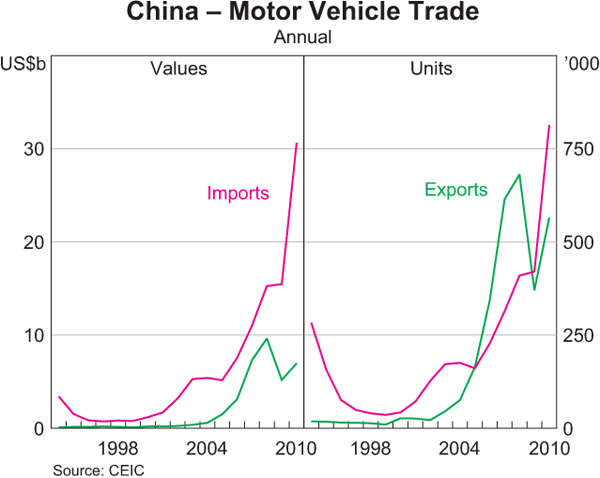
Most motor vehicles exported by China go to developing and emerging economies, with Algeria, Vietnam, Russia, Iran and Chile the top five destinations in 2010 (by value; Table 2). Advanced economies accounted for only around a tenth of total motor vehicle exports in 2010. With the joint ventures involving foreign manufacturers geared towards supplying vehicles for the domestic market, the vast majority of exports of motor vehicles are produced by the independent producers. Intellectual property issues have been a factor constraining the ability of the independent auto companies to export to developed economies, though this is likely to change as these companies continue to develop their own designs and purchase technologies from foreign car makers.
| Exports | Imports | |||
|---|---|---|---|---|
| Destination | Share of total(a) Per cent |
Origin | Share of total(b) Per cent |
|
| Algeria | 7.9 | Germany | 38.4 | |
| Vietnam | 5.6 | Japan | 24.7 | |
| Russia | 4.4 | United States | 11.6 | |
| Iran | 4.1 | United Kingdom | 7.0 | |
| Chile | 4.0 | South Korea | 5.3 | |
|
(a) Share of the total value of motor vehicle exports Source: CEIC |
||||
Growth in motor vehicle imports has also been rapid over the past decade, consistent with strong growth in incomes. Imports of motor vehicles consist mainly of ‘luxury’ cars, with nearly 40 per cent of the value of car imports sourced from Germany and another one-third or so coming from the US and Japan (by value; Table 2). Highlighting the relatively high-value nature of China's car imports, the value of motor vehicle imports has consistently exceeded exports despite the country exporting a greater number of automobiles than it imported between 2005 and 2008.[1]
In addition to motor vehicles, China also exports automobile parts and accessories, as well as motorcycles. Including these products, total automobile products accounted for around 3 per cent of China's aggregate exports in 2010, with parts and accessories accounting for the majority of such exports (Graph 5). In contrast, imports of automobile products are more evenly divided between motor vehicles and automobile parts and accessories.
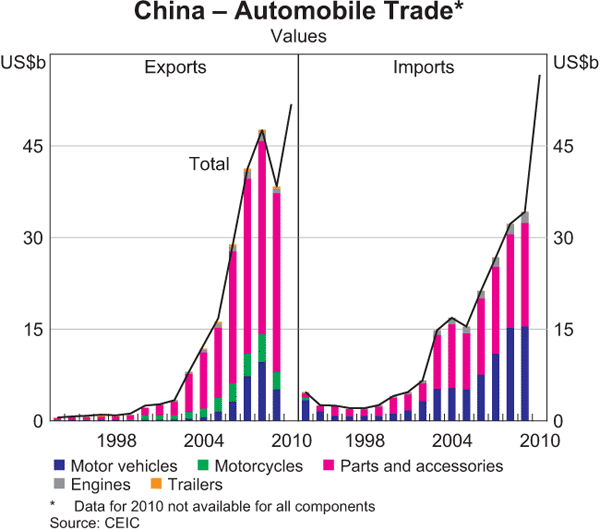
Recent Developments
After the onset of the global financial crisis in late 2008, the Chinese authorities moved quickly to stimulate the economy, including a number of policies aimed at increasing purchases of passenger vehicles. A car-scrappage scheme was introduced, whereby older cars or any vehicle that did not meet China's emission standards could be turned in for a grant of between CNY3,000 and CNY6,000. In January 2010 these grants were increased to between CNY5,000 and CNY18,000 and the scheme was extended by six months to the end of 2010.
Aside from the car-scrappage scheme, the Government also halved the sales tax on smaller vehicles in January 2009. Initially set at 10 per cent, the sales tax on cars with an engine size less than 1.6 litres was cut to 5 per cent and a further subsidy, implemented in early 2009, was paid on rural purchases of light trucks and mini-vans (up to CNY5,000 in value).[2] Following the initial policy announcement, sales of eligible vehicles increased sharply and remained at a very high level through to the beginning of 2011 (Graph 6). Overall, sales of cars with engines less than 1.6 litres have nearly tripled since the end of 2008 and have been a major contributor to the growth in overall passenger car sales. In January 2010, the sales tax on smaller vehicles was raised to 7.5 per cent which moderated growth somewhat – with sales of smaller cars up 32 per cent in 2010 compared with 71 per cent in 2009. Both the scrappage scheme and the sales tax discount expired at the end of 2010, although a CNY3,000 subsidy was introduced in 2010 and remains available on purchases of pre-approved ‘green’ cars.
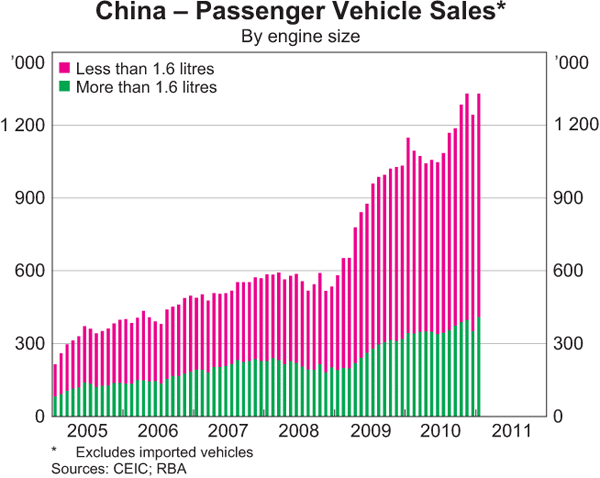
The surge in demand for cars with small engines coincided with an extremely sharp rise in imports of motor vehicles; the number of motor vehicles imported into China increased almost fourfold over the year to March 2010, thereby providing a boost to the automobile sectors of advanced economies such as Germany, the United States, Japan and South Korea (Graph 7). While it is possible that some imported cars had engines small enough to qualify for the temporarily lower sales tax, the volume of such imports is likely to have been small. This is because the average value of imported passenger vehicles is high enough to suggest that most imported vehicles were luxury cars (and therefore unlikely to have had small engines), and furthermore many German, US and Japanese automakers already produced cars with small engines within China. Accordingly, the surge in demand for imported vehicles is consistent with a strong underlying demand for cars in China that is largely unrelated to the recent policy measures.
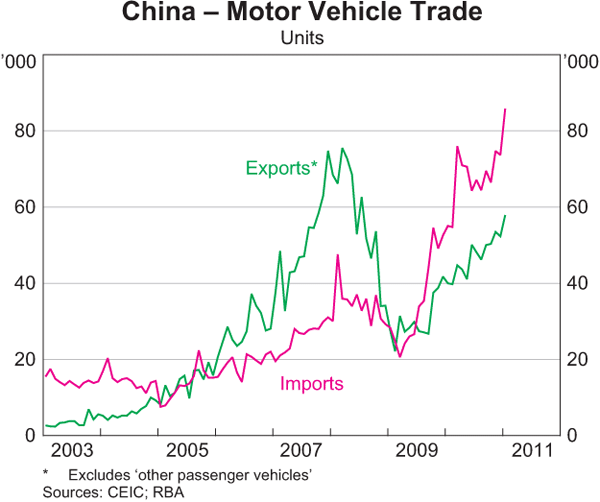
In contrast to imports, exports of motor vehicles have experienced only a modest recovery following their sharp decline around the time of the global financial crisis (Graph 7). This is consistent with relatively sluggish economic recoveries in former key export markets in eastern Europe and ongoing headwinds faced by Chinese automakers in gaining market share in advanced economies.
Future Prospects
The emergence of China as a low-cost producer of automobiles will continue to have important ramifications for the global automobile market. In 2001, China had six companies in the top 50 global automobile producers, a number that had risen to twenty-one in 2009. Some of the faster growing independent companies have been successful in expanding their presence in the global automobile market; for instance, Geely, Chery and BYD, have been building plants and selling cars in developing car markets abroad. They have also been actively trying to enter markets in advanced economies for some time, including attempts to acquire major international car brands in recent years.[3] Australia has recently started importing Chinese-produced vehicles, with passenger cars, sports utility vehicles and light trucks available for sale. While the expansion of Chinese car brands in foreign markets continues to face some headwinds, China is likely to emerge as a large exporter of affordable small-to-medium sized cars in the longer run, similar to the development pattern for both the Japanese and South Korean car industries.
Domestic sales are likely to remain high for the foreseeable future, abstracting from any short-term easing owing to the expiry of stimulus measures. As the urbanisation rate and household incomes continue to rise in China, there is likely to be continued demand for automobiles from first-time buyers. As in other countries, status is attached to car ownership in China and ‘conspicuous consumption’ is likely to play a role in boosting first-car buyer demand. Interestingly, and despite the scrappage incentives introduced by the Government in 2009, scrappage rates for passenger vehicles have remained very low (estimates suggest that less than 2 per cent of the total passenger car fleet was scrapped in 2009). Accordingly, it would seem reasonable to expect purchases by ‘replacement buyers’ to provide a growing source of demand for cars in the future.
International comparisons also suggest significant growth in the domestic market over the years ahead. The latest estimates show that for every 1,000 people in China, there are only 47 motor vehicles on the road, compared with around 800 in the United States, just under 600 in Japan and around 360 in South Korea (Graph 8). The rise in automobiles per person in China to date is comparable to the initial growth in South Korea in the 1980s. If China were to continue at a similar pace to South Korea, and assuming current population projections, the number of automobiles would stand at around 240 per 1,000 people by 2020 – a more than fivefold increase from the 2009 level (with average annual growth in the car fleet of over 16 per cent).[4] By 2030, the number of cars would stand at just under 360 per 1,000 people. However, it is worth noting that South Korea enjoyed significantly lower real oil prices during the initial expansion of its car fleet than China faces (and is likely to face), suggesting that the South Korean experience might provide an upper bound on the future growth of China's car fleet.
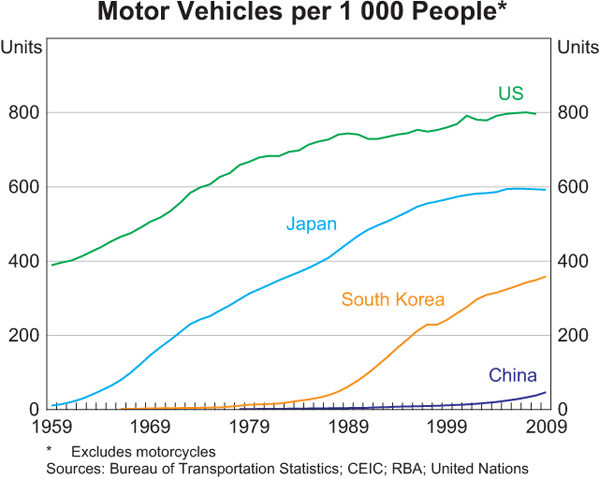
Another potential constraint on future growth in Chinese car sales is congestion, at least in the key first-tier cities, some of which have already imposed restrictions on car ownership.[5] In Beijing, for example, the Government recently announced a limit of 240,000 on new motor vehicle registrations in 2011, with 20,000 registrations assigned each month through a ballot. This limit will represent a reduction of nearly two-thirds in the number of new registrations from their 2009 level (Graph 9). With registrations in Beijing (and China more generally) portable between automobiles, the limit on registrations will restrict the number of sales of vehicles to first-time buyers. While no hard data exist on the relative size of first-time versus upgrade buyers, it is likely that the decline in sales of new vehicles will be smaller than the restrictions on new registrations imply. Nonetheless, the Beijing automobile market has been declining in importance nationally – accounting for around 5 per cent of total registrations in 2009 – suggesting that these restrictions are unlikely to have a major impact on national car sales. Beyond the near term, improved public transport infrastructure in China's cities might temper growth in demand for cars; for example, the Beijing Government is planning on nearly doubling the length of the city's subway network from its current length of 336 kilometres to 660 kilometres by 2015.
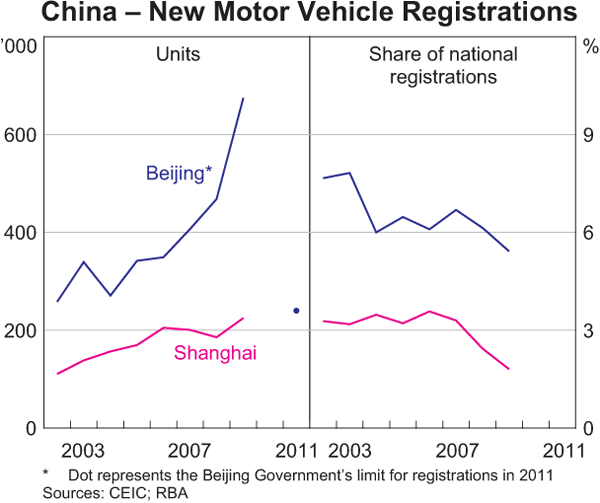
Outside the major cities, car ownership is still relatively limited, with congestion unlikely to be a binding near-term constraint on growth in the overall car fleet. China's network of highways is relatively well developed, particularly when viewed against the size of its fleet of cars; China has 2¼ million kilometres of paved roads for just over 60 million motor vehicles, compared with 2.6 million kilometres of paved roads for over 250 million motor vehicles in the US.[6] Overall prospects for the Chinese automobile sector would appear quite positive. Although near-term growth in sales and production is likely to be relatively subdued, reflecting the withdrawal of various stimulus measures, the number of cars on China's roads is likely to continue expanding rapidly over coming decades.
Footnotes
The authors are from Economic Group. [*]
Trade data indicate that the average value of an imported motor vehicle in 2009 was just under US$37,000, compared with an average value of an exported vehicle around US$14,000. In the case of passenger cars, the difference is even greater, with the average value of an imported car around US$35,000 compared with only just over US$7,000 for exports. [1]
Subsidies for purchases of motorcycles and three-wheelers were also introduced. [2]
A recent example is Geely's purchase of Ford's Volvo product line. [3]
Based on UN (2009) population projections. [4]
Since 1994, Shanghai has auctioned off new license plates to control the number of new cars hitting the roads each year. These restrictions appear to have been effective; despite having a population greater than Beijing (according to official data), new registrations in Shanghai averaged a little under 200,000 vehicles a year between 2006 and 2008, compared with an average of around 400,000 in Beijing. [5]
The data for China are from the National Bureau of Statistics, and do not include roads within medium to large cities. The US data are from the U.S. Department of Transportation, Federal Highway Administration and do not include private roads. [6]
References
CISA (China Iron and Steel Association) (2008), ‘China's Huge Appetite for Auto Steel Expected’, 8 April. Available at: <http://www.chinaisa.org.cn/news.php?id=2142126>.
MofCOM (Ministry of Commerce People's Republic of China) (2010), ‘China's Steel Industry and Policy Development after the Financial Crisis’, Presented to the 69th Session of the OECD Steel Committee Meeting, Paris, 2–3 December.
Naughton B (2007), The Chinese Economy: Transitions and Growth, MIT Press, Cambridge.
UN (United Nations) (2009), World Population Prospects: The 2008 Revision – Highlights, United Nations, New York.